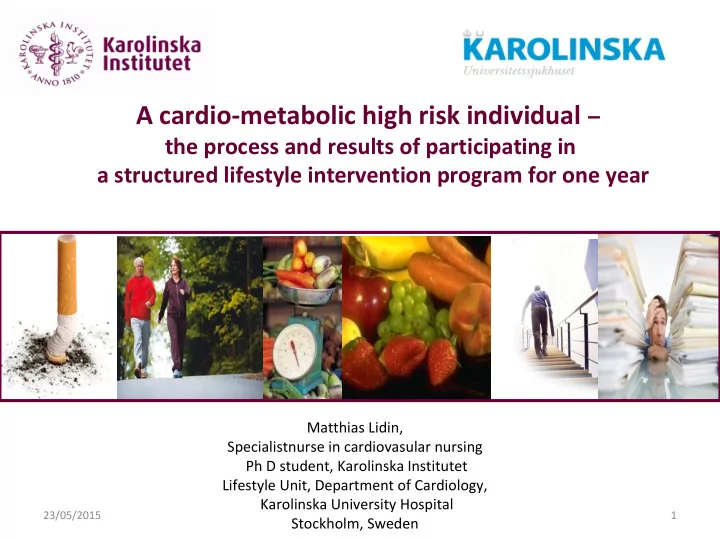

A cardio-metabolic high risk individual – the process and results of participating in a structured lifestyle intervention program for one year Matthias Lidin, Specialistnurse in cardiovasular nursing Ph D student, Karolinska Institutet Lifestyle Unit, Department of Cardiology, Karolinska University Hospital 23/05/2015 1 Stockholm, Sweden
Global burden of disease Sweden www.healthmetricsandevaluation.org
Global Burden of Disease, Sweden
The InterHEART – Study Case-control Study, myocardial infarction (n 15 152), controls (n 14 820), 74 % men, 52 different countries Psyosocial High blood lipids factors Food habits Physical Physical activity activity Alcohol High High blood pressure lood pressure Diabetes b Overweight Overweight Smoking Abdominal obesity Abdominal obesity Yusuf S et al, Lancet 2004;364:937-52
Baseline visit Case Bosse Unhealthy Lifestyle faktors Man 61 years old - Smoking Divorced - Unhealthy food habits Lives alone - Physical inactivity Taxidriver - Sedentary habits Value Parameter Blood pressure 145/85 Risk factors mmHg - Abdominal obesity Pulse 75 beats - Hypertension /min - Hyperlipidemia Weight 102 kg - Metabolic syndrome Waist 135 cm Total Cholesterol 6,5 mmol/l LDL 4,5 mmol /l HDL 0,9 mmol/l Heart score 9 %
Lifestyle intervention Intervention Primary care and hospital care Cardiovascular prevention For patiens with cardiovascular disease or risk • Individual visit – nurse based, person centred lifestyle advice, • Questionnaire, physical examination, blood samples; baseline, 6 months and 1 year • Five structured group meetings with a physician and a nurse - physical inactivity, food habits, nicotine, alcohol, stress and cognitive behavior therapy
The individual visit – nurse ü Blood pressure, heart rate, waist circumference , weight, height , BMI and Body Composition ü Fasting: Total cholesterol, triglycerides, LDL, HDL, APOB och APOA1, p-glucose, HbA1C, TSH, S-Crea, g-GT och hsCRP ü Questionnaire: quality of life, food habits , alcohol, nicotine habits, physical activity/inactivity , sedentary habits and stress ü Visit: Baseline, after 6 months and 1 year ü Documentation / Patient file ü Physical activity on prescription - PaP ü Pedometer
Life style counselling for Bosse • Person-cetered approache • Motivated behavior change interveiw techniques (MI) • Based on Science • Using Life style related tools ex • Heart score • Physical activity on precription (PAP) – PA and sedentary time / pedometer • Food brochures' ( focusing on Smart chioes ) more vegetable /less meat • Stop smoking brochures' and internet/ telephone line help
One year folow-up Case / Bosse Improved Lifestyle faktors • Non smoker Man 61 years old • Eats more vegetables/fish and Visit 6 month Visit 1 year less meat • Brisk walks and Gym-training Telephone contact • Less sedentary – pedometer –Stop smoking Value Parameter Blood pressure 120/80 mmHg Improved Riskfactors Pulse 62 beats /min • waist -curcumferens : normal Weight 95 kg • Blodpressure : normal Waist 98 cm • Cholestrol : normal Total Cholesterol 4,5 mmol/l LDL 2,8 mmol/l HDL 1,3 mmol/l Heart score 2 %
Conclusion • Reduced cardiometabolic risk in an individual participating in our structured lifestyle intervention • More studies are needed for stronger evidence and more effective implementation THANK YOU!!
Recommend
More recommend